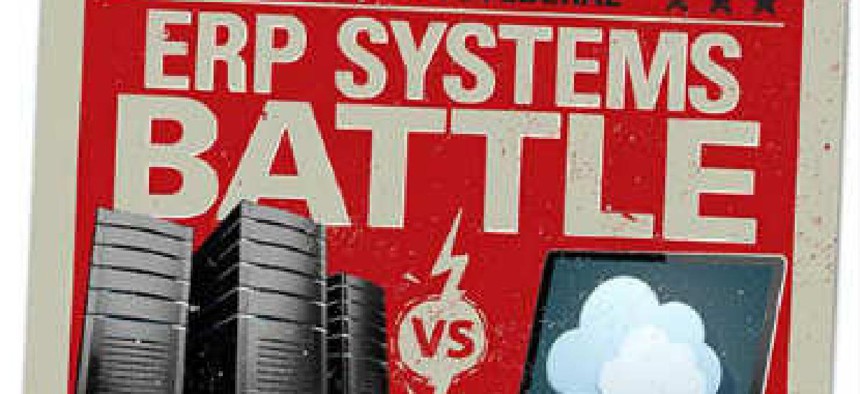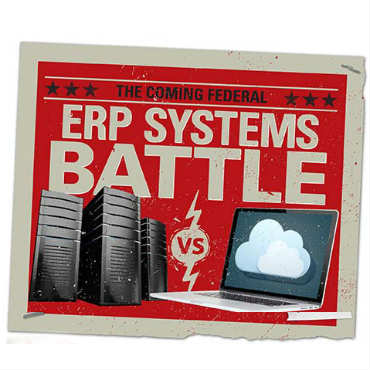The coming federal ERP systems battle

Enterprise systems, with their countless customizations and business rules, can be modernization nightmares. But innovative applications and cost considerations are pushing agencies toward the cloud.

Across government, agencies can expect their legacy IT business systems to fall behind at an accelerating rate. Vendors are aiming many of their advances in business analytics, big data and artificial intelligence at their cloud platforms and not at on-premises systems.
That approach will hit enterprise resource planning (ERP) systems hard. Chatbots, for instance, now use texting and voice in human-like, conversational formats to interface with applications. They are gaining artificial intelligence capabilities and could fundamentally change how people interact with computers.
But the most advanced chatbot technology is being designed for cloud-based environments, not traditional systems.
The big ERP vendors, the primary suppliers of business and human resource applications to federal applications, are cautiously nudging their on-premise users to the cloud. SAP says it will continue mainstream maintenance for its business systems through 2025, and Oracle is promising its premier support though 2027. After those dates different support tiers may kick in, but the vendors won't abandon users. Oracle, for instance, says legacy on premise systems such as PeopleSoft, E-Buisness Suite and Seibel are covered under its lifetime support policies.
However, they added that "support dates are reviewed regularly and sometimes extended, and many of our on-premises product lines have new versions in development."
Such vendor dates are moving targets, but long-term guarantees will offer little comfort if cloud platforms outstrip legacy systems in performance and innovation.
"The capabilities of on-premise simply cannot keep pace with cloud-based options," said Yvette Cameron, senior vice president of strategy and corporate development at SAP SuccessFactors, a provider of human capital management services. On-premises customers are "going to feel left behind over time."
Her view is broadly shared not only by technology vendors, but also by officials in the White House. Jared Kushner, a White House senior adviser, recently told an assembly of technology leaders that a majority of government systems "can be consolidated and migrated to the cloud," according to a government report of the meeting.
Indeed, the General Services Administration is viewing expiration dates for vendor support as a way to help push agencies to cloud platforms and shared services.
"We believe recent announcements to end premier support for key vendor ERP systems will continue to motivate agency IT modernization initiatives and be more cost-effective governmentwide in the long run," a GSA spokesperson told FCW. "Cloud computing has already proven itself as a viable model for ubiquitous, on-demand access to configurable computing resources."
The role of customization
Federal agencies have been shifting productivity, collaboration and infrastructure services to cloud environments provided by Microsoft, Google, Amazon and other vendors. But moving core business applications, such as those that run financial and HR services, will be much more difficult.
Ann Dunkin, who was the Environmental Protection Agency's CIO until January and is now CIO for Santa Clara County, Calif., said years of customization are keeping agencies from updating their business systems.
"You have some agencies that are really stranded on quite old versions of software," she added. These agencies "have painted themselves into a corner by doing a bunch of customizations."
Dunkin said EPA learned not to customize software because "when the new release comes out, you have to test or rewrite every one of your customizations to go to the next level." Some agencies might not bother moving such systems to the cloud, but "on the other hand, eventually functionality and security become a problem, and people have to figure out how to move."
EPA officials sought to remove customizations that could be replaced with a standard software solution, and often the software had evolved to the point that the customization was no longer needed, Dunkin said. Sometimes, however, agencies customize an application because it does not want to change its business process. She and her team quickly realized they needed to stop doing that.
Unique requirements do crop up. For example, EPA's Superfund accounting system has to do things that standard software packages don't. Customizing it involved building code outside the core system that shares its data.
"That would be the preferred practice now," Dunkin said. "You are not customizing that system, you are simply using its interfaces to share the data back and forth that you need."
When preparing for cloud migrations, agencies will need to abandon many of their customizations and change their business practices instead. They must also come to terms with how many custom-built systems they are managing, which can be a staggering number.
Jeffrey Neal, former chief human capital officer at the Department of Homeland Security, did a survey of HR systems not long before he left the department in 2011. He counted over 400. Some of them were homegrown systems that traced their roots back to the arrival of PCs.
"There is no reason for any agency in the federal government to have 400 systems," said Neal, who is now senior vice president at consulting and technology services provider ICF.
Older IT systems are an increasing cost burden. In 2010, about 68 percent of the federal IT budget was spent on operations and maintenance. That amount was forecast to rise to 77 percent this year, according to a 2016 Government Accountability Office report — due in part to the increasing cost of maintaining legacy hardware and older applications.
That growth in operations and maintenance spending means less money for new technology, and it is also being blamed for security weaknesses. Although both the Obama and Trump administrations have pushed for IT modernization investments, appropriations have been hard to come by. In May, the House approved $500 million in IT modernization funding, but the Senate had not yet acted on the measure.
The biggest impediments to change
In their push to move federal users to the cloud, vendors might face other big obstacles.
Ray Bjorklund, president of government IT market research firm BirchGrove Consulting, said he believes industry's goals will clash with the reality of government. "New ideas or innovations that the executives might recommend first have to be tested against the law, budgeting processes, financing constraints and purchasing methods," he said. "There are many strict operational constraints in the federal space; violate them and [you] risk oversight scrutiny or legal action."
Security is another frequently raised issue with regard to cloud platforms. Much of the federal data stored in Oracle, SAP and other ERP systems is protected by laws that come with criminal penalties for disclosure, said Roger Baker, a former assistant secretary for information and technology and CIO at the Department of Veterans Affairs who now works as an independent consultant.
Do vendors "really want to take on the liabilities implied with the storage of that information?" he asked. For now, federal employees "hold all that liability," Baker said, adding that the "biggest impediment to change in federal IT are requirements written into federal law."
Vendors are creating government-specific cloud environments to deal with some of those issues, but those clouds still face obstacles, Dunkin said.
For instance, all civilian agency network traffic must pass through a Trusted Internet Connection when linking to a cloud service, and DHS' Einstein program, which is designed to protect networks, also creates challenges.
Einstein "interferes with effectively using cloud services because it redirects the traffic through this device," Dunkin said. It presents problems for users inside the firewall and especially for users outside the firewall who are trying to remotely access cloud services.
Another friction point is the Federal Risk and Authorization Management Program. It standardizes security by requiring vendors to have their cloud services certified. GSA has sought to streamline the certification process, but FedRAMP is "prohibitively expensive," Dunkin said. "It really stifles innovation in the cloud."
Despite such obstacles, shifting ERP from on-premises systems to cloud platforms could allow agencies to consider new vendor options.
Sherry Amos, director of market development for education and government at Workday, believes federal agencies have the same cloud opportunities that commercial customers have. But they must decide whether their customized, unique features are justified.
"There will come a point in the not-too-distant future where all of these applications are only cloud applications," said Amos, whose company provides cloud-native HR and finance software.
Incremental steps
Neal said that for the foreseeable future, the government's core HR systems will come from the big vendors, such as Oracle. "The complexity of those systems makes it very difficult to replace them," he added.
Neal believes agencies can stay with their core on-premise ERP systems, and focus on developing interfaces that work with cloud-based services. Those systems can interface with other services, he said, and when agencies replace a tool with one that has better pricing and features, that new tool is likely to be in the cloud.
Many vendors will try to move federal users to the cloud in incremental steps. For instance, SAP SuccessFactors said some of its federal customers are adopting certain cloud-based HR functions, such as recruiting, performance measurement and goal setting.
Whatever the vendor mix, however, a smooth transition to cloud platforms is far from guaranteed. On one side will be the appeal of new automated features in vendor systems, which will have the ability to import, analyze and report without a human having to touch the data, said Matt Richards, a managing director at KPMG. "It would dramatically change repetitive tasks in an organization."
But on the other side is federal IT itself. The government has a deep bench of technologists, creative thinkers and open-source advocates. For instance, more than a dozen agencies are participating in an effort to develop artificial intelligence-based personal assistants to improve access to government services. So there could be a push for solutions that don't square with those of incumbent firms or their cloud-native challengers.
"It's not unusual for outsiders to be unaware of some of the remarkable technology innovations that have already taken root in the government, some of which are homegrown," Bjorklund said.
NEXT STORY: Alexa and Cortana Will Join Forces


